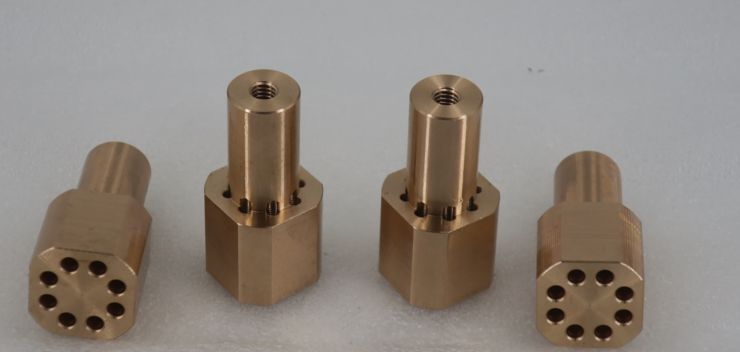Mar. 22, 2024
What is Tin Bearing Bronze Machining Parts?
Tin-bearing bronze machining parts refer to components or pieces made from bronze alloys containing tin as a primary alloying element. These parts are manufactured through various machining processes such as turning, milling, drilling, or grinding to achieve the desired shape, dimensions, and surface finish.
Tin-bearing bronze alloys, also known as phosphor bronzes, typically contain tin in varying amounts along with copper as the base metal and phosphorus as an additional alloying element. The addition of tin and phosphorus enhances the mechanical properties of the bronze, including increased strength, wear resistance, and corrosion resistance.
Machining tin-bearing bronze parts involves using cutting tools to remove material from the workpiece, and shaping it into the desired form. These parts can vary widely in complexity and size, ranging from small intricate components to large industrial machinery parts.
Common applications of tin-bearing bronze machining parts include:
1. Bearings: Tin-bearing bronze is widely used in bearing applications due to its excellent wear resistance and self-lubricating properties.
2. Bushings: Bushings made from tin-bearing bronze are utilized in various mechanical systems to provide low-friction support and reduce wear between moving components.
3. Gears: Bronze gears are employed in gear systems where high strength, wear resistance, and low friction are required.
4. Valve components: Tin-bearing bronze parts are used in valve assemblies for their corrosion resistance and dimensional stability.
5. Marine hardware: Due to its resistance to corrosion in marine environments, tin-bearing bronze is often used in marine hardware such as propellers, shafts, and fittings.
6. Electrical connectors: Bronze parts with good conductivity and corrosion resistance are utilized in electrical connectors and terminals.
7. Automotive components: Tin-bearing bronze parts find applications in automotive systems such as bushings, bearings, and valve guides due to their durability and wear resistance.
8. Automation components: Tin-bearing bronze parts used for automation systems such as washers, pivot pins, and pogo mounts.
9. Medical device components: Tin-bearing bronze also be for medical devices, such as phosphor holders for dental equipment.
Machining tin-bearing bronze parts requires a careful selection of cutting tools, cutting speeds, feeds, and coolant/lubricant to achieve optimal results while maintaining dimensional accuracy and surface finish. These parts are essential components in various industries, contributing to the reliability and performance of mechanical systems and equipment.
Tin-bearing bronze, also known as phosphor bronze, is a type of bronze alloy containing a significant amount of tin, usually between 0.5% to 11%, with phosphorus added as an alloying element. This alloy offers excellent wear resistance, good strength, and corrosion resistance, making it suitable for various machining applications where durability and reliability are essential.
When machining tin-bearing bronze parts, there are several key considerations to ensure optimal results:
Tool Selection: Carbide tools are commonly used for machining bronze alloys due to their durability and resistance to wear. High-speed steel (HSS) tools can also be used, but they may wear out faster. Select tools with sharp cutting edges to minimize tool wear and achieve better surface finish.
Cutting Speed: Bronze alloys have relatively low thermal conductivity compared to steel, so cutting speeds should be moderate to prevent overheating. Higher cutting speeds may cause the material to soften and result in poor surface finish or tool wear. Adjust cutting speeds based on the specific composition of the bronze alloy and the type of machining operation.
Feed Rate: Use appropriate feed rates to maintain chip control and prevent tool overload. A consistent feed rate helps achieve uniform cutting forces and prolongs tool life.
Coolant: Coolant or lubricant is often used during machining to dissipate heat and improve chip evacuation. Water-soluble or oil-based cutting fluids are commonly used for bronze alloys to reduce friction and prolong tool life. However, some phosphor bronze alloys may react with certain types of coolants, so it's essential to use compatible fluids.
Chip Control: Proper chip control is crucial to prevent chip buildup, which can lead to tool damage or poor surface finish. Use chip breakers or peck drilling techniques to promote chip evacuation and maintain machining efficiency.
Workingholding: Securely clamp the workpiece to minimize vibration and chatter during machining, which can negatively impact surface finish and dimensional accuracy.
Surface Finish: Achieving a smooth surface finish may require multiple passes and light cuts to minimize tool marks and surface imperfections. Consider using finishing operations such as grinding or polishing for critical dimensions or surface quality requirements.
Tool Wear Monitoring: Regularly inspect tools for signs of wear and replace them as needed to maintain machining accuracy and productivity.
By following these guidelines and adjusting machining parameters based on the specific characteristics of the tin-bearing bronze alloy being machined, we produce high-quality parts with tight tolerances and excellent mechanical properties.
Do not hesitate to send us your mechanical parts RFQs with specifications to our email mitani@rymachining.com, inquire now, get your customized parts quote today!
